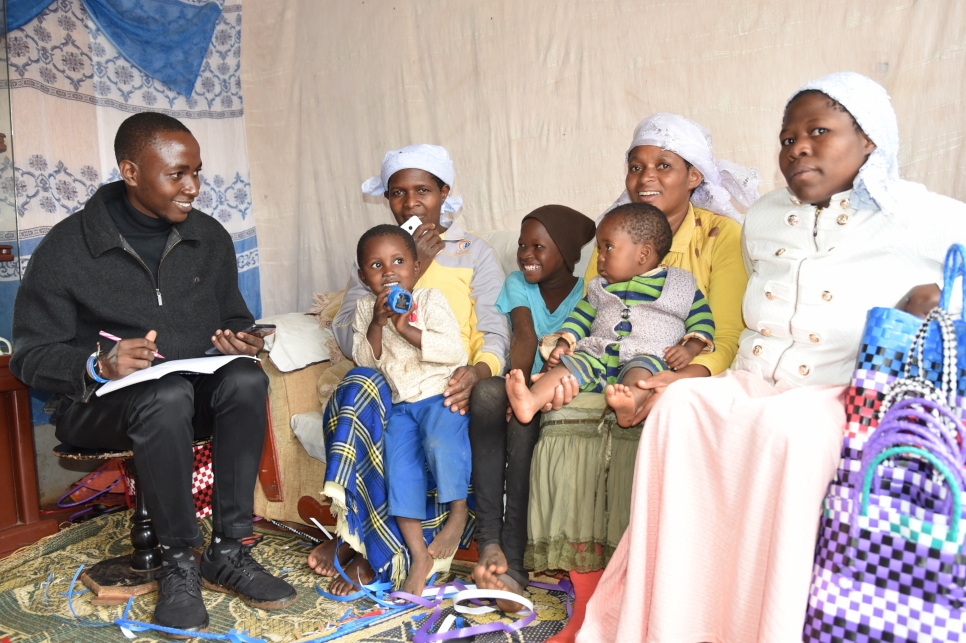Data and Analysis
Making decisions based on evidence is key to building and monitoring progress towards resilience and self-reliance of host and refugee communities and targeting aid resources in an optimal manner.
The UNHCR-World Bank Joint Data Center on Forced Displacement aims to enhance the ability of stakeholders to make timely and evidence-informed decisions that can improve the lives of affected people. It aims to:
- Ensure population and socioeconomic data are systematically collected and analyzed;
- Facilitate open access to forced displacement data, while ensuring the integrity of the legal protection framework;
- Promote innovations to enhance forced displacement data through satellite imagery, cell phones, and other new technologies;
- Strengthen the global data collection system, establishing common norms, definitions, and methodologies, and support efforts to fortify country systems where necessary.
Improving the availability of comparable microdata on multi-dimensional poverty (or simply socioeconomic data) on forcibly displaced persons and refugees is a key area UNHCR is investing in its partnership with the World Bank.
Major initiatives in this area include:
- The inclusion of forcibly displaced persons in national surveys that measure poverty. The World Bank and national governments have expanded the collection of poverty data to include refugees in three countries (Uganda, Chad and Niger). Discussions are ongoing to provide support in this area to more countries in 2020 and beyond.
- Conducting reduced versions of national surveys as part of UNHCR proGres verification exercises. Already implemented in two countries (Burundi and Kenya), discussions are ongoing to include more countries in 2020 and beyond.
- Enhancing capacity of UNHCR registries to collect more meaningful socioeconomic data. This ensures that corporate refugee data systems, primarily PRIMES and proGres, are capable of directly generating analytical insights that are useful to decision makers.
Monitoring Livelihoods Programmes
We track the impact and the cost effectiveness of both UNHCR and our partners’ livelihoods programmes through a comprehensive monitoring framework. The framework uses a set of clearly defined impact and performance indicators to both guide the design and monitor programmes. Supporting the monitoring framework is a mobile survey tool that UNHCR field operations have been using to collect beneficiary data since 2017.
The impact of livelihoods interventions is presented through an open data platform, the UNHCR Integrated Refugee and Forcibly Displaced Livelihoods Information System, which presents performance and impact indicators in a standardized, systematic way that allows for comparison across countries and regions. Such results can be further disaggregated to view impact by age, gender, legal status, location and implementing partners. The platform displays results in real time, including anonymized household datasets for download, enabling timely adjustments to programmes.
Supporting the global rollout of the Livelihoods Information System, since 2018, UNHCR has partnered with the non-governmental organization CartONG, who provides training and other technical support to all global teams.
Further resources:
- Overview Presentation of Livelihoods Monitoring (PowerPoint Presentation)
- Results of Key Indicators 2019: Charts – Blog
- Livelihoods Open Data Platform: Livelihood Information System
Research and Policy Briefs
Assessing the Socioeconomic Impact of COVID-19 on Forcibly Displaced Populations
Lebanon – Nigeria – Kenya
Estimating refugee poverty quickly using cross-survey imputation
Research paper – Summary – Blog post
Reaching the poorest refugees in Niger
Evaluation of food and cash distribution
Impact of Venezuelan flow on Roraima State in Brazil
Implications for Public Policy
Integration of Venezuelan Refugees and Migrants in Brazil
Research paper - Blog post - Socioeconomic indicators dashboard (in Portuguese)
COVID-19's impact on Rohingya and Bangladeshi adolescents in Cox's Bazar
Research paper – Blog post – Microdata
Using socioeconomic data to improve outcomes for refugees in Uganda:
- Improving employment outcomes - Summary - Policy brief - Knowledge brief
Improving welfare and food security through better land productivity: Overview of access to land and its uses by refugees in the Maratane Camp and host communities in Mozambique
Socioeconomic Comparisons of Forcibly Displaced Persons and Hosts
Using Socioeconomic Evidence for Action in Forcibly Displaced Contexts
Vol 1 June 2021: Examples of UNHCR's uses of socioeconomic data to inform evidence-based programming, policy and advocacy – French
Kalobeyei Settlement in Kenya
Full report – Summary – Infographic – Microdata
Kakuma Camp in Kenya
Full report – Summary – Infographic – Microdata
Stateless Shona Community in Kenya
Full report – Summary – Blog post – Microdata
Cox's Bazar in Bangladesh
Innovations in gathering host and refugee evidence from the Rohingya crisis in Cox's Bazar
Socioeconomic Assessment Toolkit
Cox's Bazar Panel Survey
A comprehensive, large-sample survey that tracks both host and refugee households over time in Cox's Bazar, Bangladesh
Socioeconomic Survey Planning Guide
Orientation for the early stages of planning a socioeconomic survey
Terms of Reference Template for Hiring a Survey Firm
Suggested template for preparing the terms of reference for procuring consultants
Developing a Standardized Employment Module
Capturing key employment indicators and ways to use the module
Developing a Standardized Education Module
Capturing key education indicators to measure, inform and monitor progress on a range of global education indicators
Handling differences between cases and households
Bridging the differences arising from the use of "cases" in UNHCR's proGres database and the use of "households" prescribed in standard survey methodology

